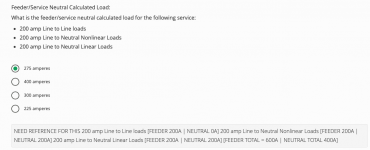Help. I'm practicing for my exam and I believe on my practice test the answer is wrong here.
200 Amp Line to Neutral (Non Linear Load) 200A @ 100%
200 Amp Line to Neutral (Linear Load) = 200A X 70% = 140A
Sorry about the caps
My selection of answer are

200 Amp Line to Line = 0 AmpsFeeder/Service Neutral Calculated Load:
What is the feeder/service neutral calculated load for the following service:
- 200 amp Line to Line loads
- 200 amp Line to Neutral Nonlinear Loads
- 200 amp Line to Neutral Linear Loads
200 Amp Line to Neutral (Non Linear Load) 200A @ 100%
- NEC 220.61(C): Nonlinear loads (like computers, electronics) contribute 100% to the neutral current because harmonics increase the neutral current.
200 Amp Line to Neutral (Linear Load) = 200A X 70% = 140A
- NEC 220.61(B): Linear loads contribute 70% of their load to the neutral. For line-to-neutral linear loads over 200 Amps, you apply the 70% demand factor.
Sorry about the caps
My selection of answer are


